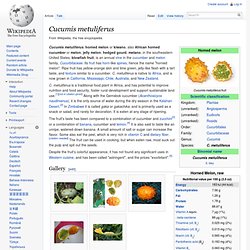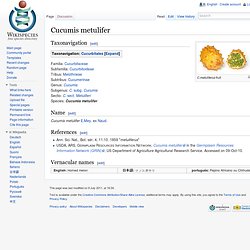

The top 10 exotic fruits. Traveling to an exotic destination is not just about swimming in the turquoise waters or sunbathing.

You also have to taste some of the cuisine and sample some of the exotic fruits of the place. For those hot summers when you need something refreshing, we have collected 10 tropical fruits you absolutely must try. 1. RambutanNative to Malay Archipelago, Southeast Asia Coming from an evergreen tree, the Rambutan fruit resembles the Lychees, have a leathery red skin and are covered with spines. Rambutan is a popular garden fruit tree and one of the most famous in Southeast Asia. Kiwano Cucumis metuliferus. 10 Most Exotic Fruits - Oddee.com (exotic fruits list) Squared Watermelon For years consumers have struggled to fit the large round fruit in their refrigerators.

And then there was the problem of trying to cut the fruit when it kept rolling around. But 20 years ago a forward-thinking farmer on Japan's south-western island of Shikoku solved the problem. The farmer, from Zentsuji, in Kagawa prefecture, came up with the idea of making a cube-shaped watermelon which could easily be packed and stored. To make it happen, farmers grew the melons in glass boxes and the fruit then naturally assumed the same shape.
Pomegranate The pomegranate is native from Iran to the Himalayas in northern India and was cultivated and naturalized over the whole Mediterranean region since ancient times. Dragon fruit A pitaya is the fruit of several cactus species, most importantly of the genus Hylocereus (sweet pitayas). Kiwano The horned melon (Cucumis metuliferus), also called African horned cucumber or kiwano, is an annual vine in the cucumber and melon family. Ackee. Horned melon. C. metuliferus is a traditional food plant in Africa, and has potential to improve nutrition and food security, foster rural development and support sustainable land use.[1][not in citation given] Along with the Gemsbok cucumber (Acanthosicyos naudinianus), it is the only source of water during the dry season in the Kalahari Desert.[2] In Zimbabwe it is called gaka or gakachika, and is primarily used as a snack or salad, and rarely for decoration.

It is eaten at any stage of ripening. The fruit's taste has been compared to a combination of cucumber and zucchini[3] or a combination of banana, cucumber and lemon.[4] It is also said to taste like an unripe, watered-down banana. A small amount of salt or sugar can increase the flavor. Some also eat the peel, which is very rich in vitamin C and dietary fiber.
[citation needed] The fruit can be used in cooking, but when eaten raw, most suck out the pulp and spit out the seeds. Gallery[edit] References[edit] External links[edit] Cucumis metulifer. C.metuliferus fruit [edit] Familia: Cucurbitaceae Subfamilia: Cucurbitoideae Tribus: Melothrieae Subtribus: Cucumerinae Genus: Cucumis Subgenus: C. subg.

Cucumis Sectio: C. sect. Metuliferi Species: Cucumis metulifer Name[edit] Cucumis metulifer E.Mey. ex Naud. References[edit] Ann. Vernacular names[edit] English: Horned melon日本語: ツノニガウリportuguês: Pepino Africano ou Chifrudo.